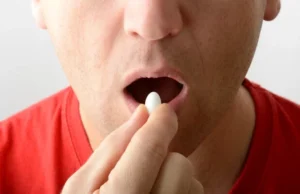Ever found yourself turning unexpectedly red and warm after taking medication? You're not alone. This reaction, known as flushing, is a common side effect of many medications. Whether it's a flushing medication side effect you're experiencing or you're just curious about what causes this reaction, you've come to the right place.
This article delves deep into the phenomenon of flushing from medication, offering insights into its causes, management, and much more. Stay with us as we navigate the reactions to medications that can bring about this flush of inconvenience.
Understanding Flushing: An Overview
If you've ever wondered, What is flushing from medication? let's clear the air.
Flushing refers to a sensation of warmth and visible redness, usually occurring on the face, neck, or upper chest. This reaction can stem from a wide range of medications, from niacin to vasodilators and beyond.
 It happens when blood vessels expand, leading to an increased blood flow to the skin's surface. Though often harmless and temporary, flushing can sometimes serve as a marker for an allergic reaction or other side effects, necessitating a closer look at the medication in question.
It happens when blood vessels expand, leading to an increased blood flow to the skin's surface. Though often harmless and temporary, flushing can sometimes serve as a marker for an allergic reaction or other side effects, necessitating a closer look at the medication in question.
Recognizing flushing and understanding its triggers is the first step in managing this intriguing yet occasionally bothersome medication side effect. Being informed enables you to respond appropriately should you experience this warm wave of color.
The Causes Behind Flushing as a Side Effect of Medication
Understanding the flushing side effect of medication involves diving into the myriad reasons why medications lead to this response.
Medications such as anti-hypertensives, which dilate blood vessels to lower blood pressure, can often trigger flushing. Similarly, medications such as niacin, used to treat high cholesterol levels, cause vasodilation, resulting in a flush.
Even some chemotherapy agents and opioids are known to induce flushing.
This response arises not because the body is rejecting the medication, but as a direct consequence of how these drugs interact with the body's systems, particularly the vascular system. Recognizing the types of medications that can cause flushing is essential for anyone experiencing this condition, empowering them with the knowledge to discuss potential side effects and alternative treatments with their healthcare provider.
How to Manage Flushing Reaction to Medication
Experiencing a flushing reaction to medication can be uncomfortable, but there are ways to manage it effectively. Initially, staying hydrated and avoiding triggers such as hot beverages, alcohol, and spicy foods, which can exacerbate flushing, is beneficial.
 Cooling techniques, like using a fan or applying a damp cloth to affected areas, can provide immediate relief. Antihistamines may sometimes be recommended to reduce flushing in certain cases, under the guidance of a healthcare professional.
Cooling techniques, like using a fan or applying a damp cloth to affected areas, can provide immediate relief. Antihistamines may sometimes be recommended to reduce flushing in certain cases, under the guidance of a healthcare professional.
Additionally, discussing medication adjustments with your doctor is crucial; alternatives that do not cause flushing may be available.
It’s key to approach management proactively, keeping a log of flushing episodes and potential triggers to identify patterns that could inform treatment adjustments. This pragmatic approach can significantly alleviate the discomfort associated with medication-induced flushing.
Preventing Flushing from Medication: Tips and Tricks
While flushing from medication can sometimes be inevitable, there are preventive measures that can minimize its occurrence.
Firstly, choosing medications known for a lower risk of causing flushing, under a healthcare provider’s guidance, is a practical step. Gradually increasing medication dosages allows the body to adjust, potentially reducing flushing intensity.
For instance, if taking niacin, starting with a lower dose and gradually increasing it might help the body adapt without significant flushing.
Bathing in cool water before taking medication known to cause flushing can preemptively cool the body, reducing the severity of flushing episodes. Dietary adjustments, particularly reducing hot drinks, alcohol, and spicy foods consumption can also mitigate flushing instances. Adopting these tips doesn’t guarantee complete prevention but can significantly reduce the frequency and intensity of flushing, improving overall comfort levels during medication.
Flushing Due to Medication: Identifying Trigger Medications
Recognizing flushing due to medication involves pinpointing the specific drugs that often lead to this reaction.
 Among the common culprits are vasodilators, which widen blood vessels, and medications like niacin, used for high cholesterol. Other notable triggers include certain antibiotics, corticosteroids, and even some cancer treatments.
Among the common culprits are vasodilators, which widen blood vessels, and medications like niacin, used for high cholesterol. Other notable triggers include certain antibiotics, corticosteroids, and even some cancer treatments.
It’s essential for patients and healthcare providers to closely monitor any flushing symptoms that arise after starting a new medication or altering dosages.
Keeping a detailed diary of medication intake and subsequent flushing episodes can aid in identifying the offending drug. This vigilant approach allows for a nuanced understanding of one’s reaction to particular medications, facilitating tailored treatment plans that minimize discomfort while maintaining therapeutic efficacy. Recognizing trigger medications is a collaborative process that significantly enhances patient care and comfort.
When Flushing Indicates a Problem: Insights for Healthcare Providers
The phrase, the nurse is flushing a medication lock with saline and notes resistance.
The nurse, brings attention to instances when flushing may indicate a more severe issue than a mere side effect. For healthcare providers, noting resistance when flushing a catheter, combined with patient reports of flushing, could signal an infection or blockage – conditions that require immediate attention.
Additionally, while flushing is often benign, a sudden or intense reaction may hint at an allergic reaction, interaction with other medications, or severe side effects.
Healthcare professionals must carefully evaluate these symptoms, taking into account the patient’s medication regimen, history, and any other relevant factors, to discern the underlying cause. Prompt identification and intervention can prevent complications and ensure patient safety. It underscores the importance of keen observation and swift action in the face of adverse reactions like flushing, bearing in mind the delicate balance of effective medication management and patient well-being.
